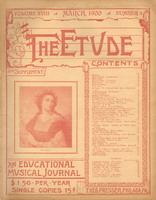BY ESTELLA M. HILLMAN.
Is a young teacher from a small country town allowed “to speak in meetin’?” If so, I should like to tell the readers of the Etude about my blackboard class. I read greedily all the articles telling of different ways to interest small children in music; but, as I have seen no plan just like mine, I wish to contribute my mite to the general fund.
I have my little pupils of the first and second grades meet together one hour per week to learn the “dry” part of music. I have a roll blackboard on which several staves are painted, which constitutes the base of operations. The little folks take seats facing the blackboard, and something like this ensues: “Clara may go to the board and write a treble clef,” I say.
Clara rises, takes a piece of chalk, and neatly draws, a treble clef on one of the staves.
“Now, Frances,” I say, “what shall she write next?”
Frances probably says: “Middle C, whole note.”
Then Wilma calls for “Upstairs C, dotted quarter note.” This may be followed by “B, a one-hundred and twenty-eighth note,” or “A, dotted sixteenth note,” etc., each member of the class in turn calling for a certain note. If a wrong note is written, it is amusing to see the sparkling eyes, and shaking heads or waving hands of the others.
Then another little girl takes Clara’s place, and the same program with variations is gone through again. They learn the bass clef in the same way; and it is surprising to find how quickly the notes become fixed in their minds. Often, to vary the proceedings, I take the chalk, and with either treble or bass, clef at the beginning of the staff, I write whole notes as rapidly as they can read them; then I change to notes of different lengths.
I also use this opportunity to teach the different rhythms, starting with common or 4/4 time as a basis; and in a surprisingly short time they can measure any little exercise in any of the simple rhythms. From this I lead them on to the compound rhythms, which are somewhat harder for them to understand.
My little pupils learn their scales from dictation: but in the blackboard class they write them (usually in whole notes), actually going through the process of forming each new scale from the preceding one, putting in the sharps or flats where they belong, and knowing the reason they do so. Often one of the number goes to the piano and plays the scale under consideration, sometimes purposely leaving out the sharps or flats to note the effect; but the whole class always decides that the right way “sounds the best.”
Of course, when first beginning, I give them little sentences to help them remember the lines and spaces; such as, “Every Good Boy Does Finely,” etc. But they soon outgrow these, and are ready for more difficult problems. Some time ago I had a blackboard class who did quite a little work in preparatory harmony; and the funny part of it was that they didn’t know it. The word “harmony” would have frightened them into all sorts of mistakes; but “harmonic and melodic minor scales,” “principal chords in the key,” and “the three positions of each chord” had no terrors whatever for them. With the blackboard class I have at present, I am trying to work in ear-training also; but, although the progress is sure, it is very slow. I hope in time to evolve some scheme by which their progress will be as rapid in this as in the memory- work. If any of my co-workers has anything to suggest on this subject, I shall be glad to hear it.
I hope my plan for blackboard work will be adopted by some one else, and will prove as valuable to him or her as it has to me. If so, I have not written in vain.



